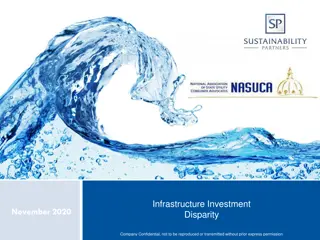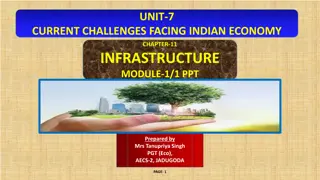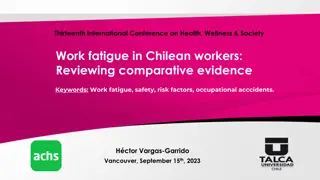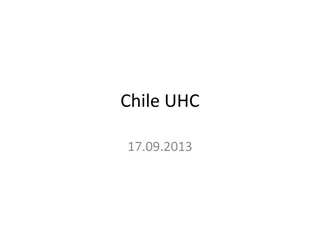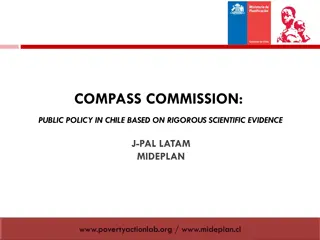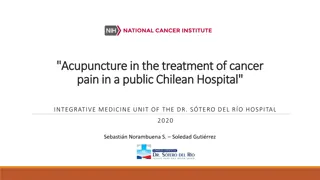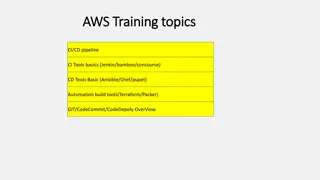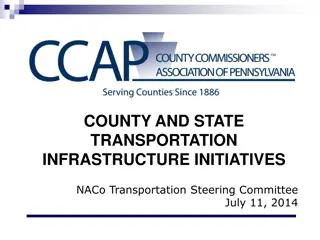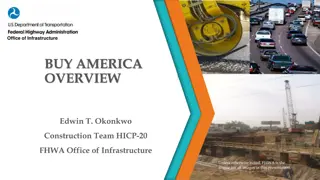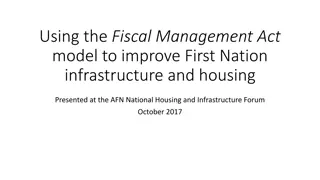Challenges and Progress in Chilean Infrastructure Development
The challenges of Public-Private Partnerships (PPPs) in Chile within the framework of best practices and international standards are discussed, highlighting the need for long-term infrastructure planning and enhanced governance. The 2017 OECD Infrastructure Governance Review identified deficiencies in Chile's infrastructure planning, prompting reforms to align with climate mitigation strategies and address social equality demands post-2019 social unrest. Recent global macroeconomic shifts and infrastructure trends also impact Chile's infrastructure development landscape, calling for adaptability and stakeholder engagement. The 2020 OECD Recommendation on the Governance of Infrastructure underscores the importance of a life-cycle approach, strategic planning, stakeholder participation, and resilience in infrastructure governance.
Download Presentation

Please find below an Image/Link to download the presentation.
The content on the website is provided AS IS for your information and personal use only. It may not be sold, licensed, or shared on other websites without obtaining consent from the author. Download presentation by click this link. If you encounter any issues during the download, it is possible that the publisher has removed the file from their server.
E N D
Presentation Transcript
The challenges of PPPs within the framework of best practices and international standards Sistema de Concesiones al 2050 Edwin Lau Head of Division Infrastructure and Public Procurement Public Governance, OECD Edwin.LAU@oecd.org 1
What potential infrastructure agenda for Chile? 2
2017 OECD Infrastructure Governance Review of Chile 2017 OECD Infrastructure Governance Review of Chile A key weakness identified in Chile s governance framework is the lack of medium- to long-term infrastructure planning, particularly in the central government. The project evaluation and prioritisation system will need to accommodate transversal issues and multiple policy goals. Chile s central government is characterised by a high degree of compartmentalisation. To ensure value for money, infrastructure planners need to adopt a whole-of-life approach with sufficient capacities at each stage of the project life cycle.
What has changed since the OECD review in 2017? What has changed since the OECD review in 2017? In Chile: Chile has established mechanisms to ensure that infrastructure strategies and plans contribute to climate mitigation strategies (e.g., NDCs, net-zero strategies, LT-LEDS): Estrategia Nacional de Electromovilidad, Energ a 2050 Chile and Certificaci n Educaci n Sustentable. 2019-20 Estallido Social with calls for greater social equality In the global environment: Significant global macroeconomic changes since COVID-19 pandemic & the war in Ukraine: Normalisation of higher interest rates and non-transitory inflation Supply chain disruptions & greater uncertainty due to climate disasters Continued globalization of infrastructure actors Reports of declines in contractor bids leading to less competition Re-emergence of concern for Paris and SDG agenda, following COVID-19
2020 OECD Recommendation on the Governance of Infrastructure 2020 OECD Recommendation on the Governance of Infrastructure Life cycle approach Strategic planning Co-ordination across levels of government Long-term strategic vision for infrastructure Stakeholder participation Fiscal sustainability, affordability, and value for money Efficient and effective procurement Stakeholder participation Procurement Critical infrastructure resilience Life cycle performance Regulatory framework Management of threats to integrity Evidence-informed decision making 5
Going Net Zero will require infrastructure investments in alternative Going Net Zero will require infrastructure investments in alternative energy, efficiency and changes in consumption energy, efficiency and changes in consumption Average annual clean energy investment and financing in the Announced Pledges and Net Zero Emissions by 2050 scenarios Investment by technology Source of finance 4 Trillion USD (2020) Technology Low emission fuels 3 Efficiency and end-use Clean electricity 2 Source of finance Public 1 Private APS NZE APS NZE 2016-20 2016-20 2026-30 2026-30 Clean energy investment climbs to USD 4 trillion by 2030 in the NZE, with most growth in emerging and developing economies. Globally 70% is financed by private actors; public finance plays a critical catalytic role and in networks. 7 Source: IEA (2020)
Need for scaling up private investment in sustainable infrastructure Need for scaling up private investment in sustainable infrastructure Source: World Bank, 2022 PPI Annual Report Main bottlenecks: poor quality and non-standardised data, risk allocation and incentives Challenging context: rising interest rates, uncertain supply chains Reputational risk: increasing demand for sustainable & quality infrastructure projects Infrastructure investment gap needs to be closed by improving targeting and performance of public investment as well as attracting private investment. 8
Challenges for investment in sustainable infrastructure Challenges for investment in sustainable infrastructure Traditional planning and decision-making frameworks and instruments for infrastructure investment are ill- adapted for accommodating multiple objectives. Uncertainties environments create a challenge for long-term infrastructure planning. arising from rapidly changing Governments have a strong incentive to prioritise infrastructure investments with high visibility resulting in short-sighted investments. Multi-level governance is required to plan and deliver on sustainable infrastructure.
Chile could do more to incorporate climate considerations into its Chile could do more to incorporate climate considerations into its infrastructure planning & delivery infrastructure planning & delivery DRAFT / UNDER DEVELOPMENT 10 NOTE: These data are based on transport sector only.
Chile has established Chile has established goals and targets in the infrastructure plan to goals and targets in the infrastructure plan to promote sustainable infrastructure promote sustainable infrastructure 11 Source: 2020 OECD Survey on the Governance of Infrastructure
Chile has aligned its infrastructure plan with environmental and Chile has aligned its infrastructure plan with environmental and climate action plans climate action plans 12 Source: 2020 OECD Survey on the Governance of Infrastructure
Governance for sustainable infrastructure investment Governance for sustainable infrastructure investment A strategic, long-term approach to infrastructure to respond to climate change.Infrastructure choices lay the framework for the energy transition & influence consumption. Taking lifecycle costs into account strengthens investment in quality infrastructure, improves resilience and incentivizes maintenance. 2) Better governance to strengthen efficiency, fight corruption & build citizen trust 1) Green & resilient infrastructure for Sustainable & Inclusive Growth Infrastructure governance improves spending and delivery by integrating high-level commitments, improving coordination and policy coherence, and balancing short- and long-term interests. 4) Multi-level governance for sustainability & addressing regional imbalances 3) A project pipeline that attracts innovative & sustainable financing Good infrastructure governance attracts private investment by improving project selection and management, reducing waste, and improving risk assessment. Public investment has long-term consequences. Infrastructure investment in today s economic recovery packages will shape transportation, energy, land use, regional development and much more for a generation.
Strengthening value for money and social legitimacy 14
Infrastructure governance for project bankability and social legitimacy Infrastructure governance for project bankability and social legitimacy Strategic vision: Operationalising national plans into project appraisal criteria for a pipeline of investable projects Clear & predictable government plans for reaching NETZERO, including the required infrastructure investment Integrating environmental & social considerations into cost- benefit analysis Project Capacity, Alignment & Delivery Strategic Vision Ensuring delivery capacity Responding to increased uncertainty with new approaches to public-private collaboration and evidence-based contracting Ensuring the needed public sector skills for project preparation, contract management and infrastructure procurement Sustainablility Dialogue between public & private sectors (and citizens!) on sustainability outcomes to align the expectations and to increase clarity, transparency & trust Reducing investor uncertainty through more standardised and transparent project reporting Demonstrating access & value for money to users Strengthening the acceptability & legitimacy of investments
What PPP and concessions framework is required? What PPP and concessions framework is required? Next year, the OECD will begin updating its 2012 Recommendation on PPPs to focus on key issues such as the value for money and risk allocation: A continuous concern for PPPs and traditionally financed major projects alike has been an insufficient competition (Roumboutsos, 2019). Large contracts based on fixed price (the very same PPPs rely on) are becoming untenable due to the contractor s exposure to high-impact low-probability (or HILP) risks or colloquially uncertainty, leading to market exists (2023 OECD expert meeting on construction risk management in infrastructure). The trust in PPPs as a procurement tool is challenged because countries were unable to defend the choice for PPPs on a value for money basis (and also because of integrity failures). One of the major foundations on which the PPPs were supposed to deliver value for money are challenged, i.e., the presence, sustainability, and the effectiveness of competition for major projects, which is directly related to the risk allocation in PPPs. OECD countries have mandated independent institutions (e.g. economic regulators or supreme audit institutions) to carry assessments of the PPP programs and highlight the main pitfalls and ways forward 16
A holistic risk management framework: A holistic risk management framework: OECD Support Tool for Effective Procurement Strategies (STEPS) OECD Support Tool for Effective Procurement Strategies (STEPS) A one contract for a project (= one-size-fits-all risk allocation) is easy to administer, but not efficient DBB with schedule of rates A collaborative delivery model DB contract Hold-up risk Persistent post-contract uncertainties causing hold-up risk Competition failure risk 17
Integrity is key to build trust in PPPs Integrity is key to build trust in PPPs 18
Chile could further promote stakeholder participation in infrastructure Chile could further promote stakeholder participation in infrastructure decision making decision making DRAFT / UNDER DEVELOPMENT 19
Example of an early adopter of concessions -- Transport Regulatory Agency in France (ART) 20
The French motorway sector: The motorway concession companies The French motorway sector: The motorway concession companies Over 75 % of the French motorway network is conceded to 20 motorway concession companies (but behind them are just 3 major players so competition is a problem) A French concession contract is a Private Public Partnership that has three features : (i) it is a global contract ; (ii) It based on user-pay principle ; (iii) it is long term contract 21
France France will in view of the expiry of the historical contracts in view of the expiry of the historical contracts in 10 will examine examine three threeaspects of aspects of of the current model of the current model in 10 years years time time 1 2 3 ANALYSIS N 1 ANALYSIS N 2 ANALYSIS N 3 Concerning the geographical and temporal scope of contracts Regarding risk-sharing arrangements On the modalities for revising contracts Consideration should be given to the appropriateness geographical redistribution of concessions Reducing the concessions is desirable and possible in future contracts A five-year review would make it possible to parameters negotiated in the context of amendments and to systematize opportunity studies Before launching new tenders, an analysis of each model should be conducted, particularly with regard to the transfer of traffic risk of a revise the duration of cost and
The options for the next stage of motorways concessions in France The options for the next stage of motorways concessions in France 1. The state takes over the concessions after expiry in a SoE regulated model. 2. The existing concession model is amended (shorter concessions, get better at benchmarking so renegotiations do not lead to rent capture) 3. The existing model is amended , and concessions are broken down to sections of 300km in length (a massive boost to competition for the contract; but at the expense of three big French incumbents) DRAFT / UNDER DEVELOPMENT 23
Blue Dot Network: improving information on quality infrastructure Blue Dot Network: improving information on quality infrastructure investments for investors and citizens investments for investors and citizens What are the aims of the Blue Dot Network? Provide a trusted signal to investors, communities and other stakeholders that a project is aligned with internationally-agreed standards of quality infrastructure investment and has addressed a number of key risks. Streamline and synthesise standards to make infrastructure development more efficient. Promote infrastructure investment in developing and emerging economies in concert with global initiatives that share similar values such as PGII and Global Gateway. Who is Blue Dot Network for? The Blue Dot Network certification is an inclusive framework open to infrastructure projects across all major infrastructure sectors in both developed and developing economies.
Benefits of the Blue Dot Network for stakeholders Benefits of the Blue Dot Network for stakeholders Help identify investable projects Provide reassurance that key risks have been addressed Facilitate due diligence Improve data availability Create a global level playing field Streamline ESG standards and reporting Meet requirements of major financing institutions Assist in raising financing Contractors and project developers Investors Communities Governments Local economic development Access to quality infrastructure services Improvements to well-being Local jobs Avoidance of harm to communities and the environment Achieve sustainable development and climate goals Attract private investors Ensure projects deliver value for money Avoid negative impacts on communities
OECD resources for improving infrastructure planning & delivery OECD resources for improving infrastructure planning & delivery
For more information, please contact: Edwin Lau (Edwin.LAU@oecd.org) DRAFT / UNDER DEVELOPMENT 28
Towards a holistic risk management framework Towards a holistic risk management framework going beyond STEPS going beyond STEPS Market structure - capabilities data (competition issues at what activity) Which is the right option and stakeholder management issues Unhappy stakeholders can force changes to the project scope later=> causes problems in execution Category managers checking supply chain Delivery entity (capabilities organisation, leadership, ) Planning/ appraisal and value distribution STEPS Standard Initial detailed risk analysis (the tech. reasons) Execution of procurement strategy (the commercial implications) Using AI to predict procurement failures Iteration of solutions Repository of post contract procurement failures from all projects 29
VfM process more likely for PPP relative to traditional infrastructure projects Formal process/legal requirement to demonstrate value for money in infrastructure projects C. PPPs D. TIPs PPPs TIPs Yes for all projects (10) MEX NZL LUX Yes for those projects above a certain threshold (5) PRT LUX ITA HUN IRL Yes for all projects (8) ITA CZE Yes for those projects above a certain threshold (6) ISR GRC IRL ISR JPN GBR GBR JPN NLD DEU DEU NLD SVN CHE CHE NOR ESP AUS Yes on an ad-hoc basis (2) AUS SVN TUR NZL SWE ESP Not DNK MEX HUN applicable (2) GRC Yes, other (1) AUT SWE FRA TUR Yes on an ad-hoc basis (3) CHL CHL DNK SVK AUT SVK CZE NOR FRA No (5) Yes, other (2) No (7) 30
Chile would benefit from a life cycle approach to project appraisal and Chile would benefit from a life cycle approach to project appraisal and selection selection Costs estimated to assess affordability of new infrastructure projects, 2020 31 Source: 2020 OECD Survey on the Governance of Infrastructure
Are regulatory frameworks fit for purpose for timely and sustainable Are regulatory frameworks fit for purpose for timely and sustainable infrastructure delivery? infrastructure delivery? DRAFT / UNDER DEVELOPMENT 32
Chile could strengthen its infrastructure integrity framework by Chile could strengthen its infrastructure integrity framework by adopting a risk adopting a risk- -based approach based approach Is each major infrastructure undertaking backed by an assessment of public integrity risks, identifying as a minimum specific types of relevant integrity breaches, the actors likely to be involved, as well as the expected likelihood and impact if the risk Yes, always (100% of the time) Austria, Colombia, Italy, Korea, Portugal, Switzerland 6 Yes, in most cases (more than 50% of the time) Finland, Ireland, Lithuania, Slovak Republic, Slovenia, Sweden 6 Yes, sometimes (around 50% of the time) Estonia, Mexico, New Zealand, Poland, United States 5 Yes, seldom (less than 50% of the time) Belgium, Czech Republic, France 3 No, never (0% of the time) Canada, Chile, Costa Rica, Iceland, Japan, Latvia, Norway, Spain, United Kingdom 9 0 1 2 3 4 5 6 7 8 9 10 33
Guidance on stakeholder participation Guidance on stakeholder participation Existence of a national guidance on stakeholder participation, 2022 Source: 2022 OECD Survey on the Governance of Infrastructure 34
Chiles infrastructure planning and procurement could integrate better Chile s infrastructure planning and procurement could integrate better gender and inclusion considerations gender and inclusion considerations promote gender equality in infrastructure procurement, 2020 Provision of support to the procurement workforce on how to Alignment of the infrastructure plan with inclusion and gender mainstreaming policies, 2020 C C C C C C C es C es C C o o C C C 35 Source: 2020 OECD Survey on the Governance of Infrastructure
What do we do ? ART s concrete action in the motorway sector ART regulates motorway companies for the direct and indirect benefit of users selects supplies ART monitors the procurement procedures implemented by concessionaires for construction works, materials and services Suppliers economic regulation for the indirect benefit of users tariffregulationfor the direct benefit of users Upstream markets Operators of motorway service areas Motorway company State ART monitors the procurement procedures implemented by concessionaires for the operation of service areas Downstream markets Related markets ART issues an opinion on the evolution of toll tariffs when contractual amendments are made and when new concession contracts are awarded ART verifies that a criterion relating to fuel price moderation is applied to select the applicant Users
What do we do ? ART s reports on the economics of concessions ART plays a unique role in shedding light on the economics of motorway concessions 2020 2023 To provide explanations on a model that has been highly criticised Open the debate on the future of the concessionary motorway network (2031-2036) 37
Three aspects of of the current model need to be re-examined in view of the expiry of the historical contracts 1 - One question deserves to be asked: who should bear the traffic risk? the State? users? Traffic risk carried by Private-public partnership & toll varying according to the traffic Higher tolls if traffic is low, and conversely inefficient use of infrastructure Private-public partnership & trafic-independent toll State budget burdened in times of recession, and vice versa the contract holder? Concession If assessed in a competitive framework, these costs should be limited Tolls incorporating the concessionaire's risk-bearing costs less use of the infrastructure 38
Three aspects of of the current model need to be re-examined in view of the expiry of the historical contracts 2 The scope of the contracts should be reduced The current model is characterised by long duration contracts, which implies: - Impossibility of regular re-tendering - Inevitably, new needs emerge during the course of the contract - Necessary negotiations with the incumbent, who is in a strong position The size of concessions should remain sufficient to maximise scale effects However, reducing the geographical scope of concessions would limit barriers to entry when contracts are reallocated One solution for reconciling the possibility of major investments and short contracts is the payment of a balance by the incoming contract holder to the outgoing contract holder The duration of future contracts should be shorter than that of current contracts: considering the constraints on road management, a contractual duration of around 20 years would be relevant
Three aspects of of the current model need to be re-examined in view of the expiry of the historical contracts 3 Contract review procedures should be improved In the current framework: - Financial parameters of the amendments are never reviewed although they are established outside any competitive procedure - Investments are made on the basis of rudimentary cost and opportunity studies Competitive tendering is the only case in which the concessionaire has no market power As is already the case today, the parameters resulting from the competitive bidding process should not be revised during the course of the contract (except through the effect of mechanical clauses from the initial contract) Strengthening regulation by regularly (e.g., on a five-yearly basis): - reviewing the negotiated parameters - systematising cost and opportunity studies






